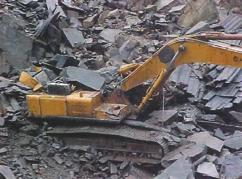Design of Working Face
There is potential for a major incident, such as the collapse of a quarry face or a person or vehicle falling if the quarry face design and stability are inadequate, or if the measures in place to prevent such falls are insufficient. When deciding upon the height, width and orientation of a quarry working face or a sand and gravel operation and the overall design, the following must all be taken into account: |  |
- an overall assessment of the geological features of the deposit, with particular reference to:
- the strength of the rock mass,
- its relevant history,
- hydrogeology,
- external influences, and
- structural orientation of the geological surfaces that will affect the quarry;
- designed orientation of the quarry faces to optimise stability for blasting and excavation, including failure modes and how they will be managed;
- the bench elevation, chosen to minimise the production of large rocks at the highest face elevations;
- the excavation method, selection of suitable equipment, and how this minimises risk to the quarry personnel;
- an assessment of the suitability of the design for short and long-term stability and maintenance of the faces;
- an indication of the probability of failure or the factor of safety of the overall excavation;
- competencies, duties and authority of those involved in the design of the quarry and how they fit into the management structure;
- competencies, duties and authority of those involved in coordinating geotechnical matters and production methods to ensure the safety of people at or affected by the quarry workings;
- how the blast design is changed to take account of face orientation and the requirement to produce safe faces; this may include:
- changing blast ratios,
- hole diameters, or
- using specialist blasting techniques;
- the inspection and remediation scheme including the competencies of those involved in identifying and implementing problems and remedial measures;
- what must be done before the quarry ceases operations or is abandoned to ensure that it is left, so far as is reasonably practicable, in a safe condition.
- The tip and excavation rules should:
- convey to all personnel the relevant design issues which affect their working methods,
- be regularly reviewed and
- be monitored and audited for their effective implementation;
- In addition to the geotechnical issues, the design must also allow adequate space for haul roads with provision for safety features as necessary, i.e.
- suitable road widths, with
- inner rock trap and berm,
- outer edge protection and
- face edge stand-off.
